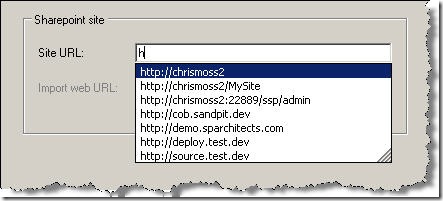I'm happy to announce that development/testing of the next version of the SharePoint Content Deployment Wizard is now complete, and the new release has been uploaded to Codeplex. If you're not aware of the tool then Introducing the SharePoint Content Deployment Wizard is a good place to start. I'm calling this release "beta 2", which indicates the tool is by no means complete, but is significantly more mature than the original version. I'd encourage all of the 1400+ people (and counting) who downloaded the original in the past few weeks to get the latest version - the link is at the bottom of this post.
So let's run through the improvements:
- Better support for large sites:
The treeview of the site is no longer built in one hit - instead, portions of the site are retrieved as webs/lists are expanded. This can make a huge difference when working with large sites.
- Support for WSS-only sites:
The dependency on the MOSS assembly (Microsoft.SharePoint.Publishing) has now been removed, so imports/exports to WSS sites are now possible. The MOSS-specific functionality is only used if we are indeed in a MOSS environment - if you're interested, this is just related to honoring any publishing schedules (i.e. page expiry) from the source site on the target site.
- Everything in one .exe:
No separate WizardBase.dll any more.
- Easier access to log files after import/export:
Since it's highly important to analyze the log file for errors/warnings after an import/export, these now open automatically in notepad at the end of the operation. There's also a link in the tool to open the log file, so no more manual digging around the filesystem.
- Auto-discovery of sites in 'Site URL' box:
No need to re-enter the site URL each time - the sites available for selection in your SharePoint environment are automatically shown in the auto-complete entries for the textbox:

- Pretty icons in treeview :-)
Easier visual distinction between objects in the tree:

- Logging via System.Diagnostics.Trace:
In addition to the log file generated by the actual import/export operation, general operations in the tool are now also logged (separately) via System.Diagnostics. So if you have a problem using the tool, it should be easier to pinpoint the actual error - enable by adding a .config file with a TraceSwitch entry for "COB.SharePoint.Utilities.ContentDeploymentWizard" and appropriate TraceListener entries.
- More reliability:
Miscellaneous minor bug fixes, including removal of the somewhat psychedelic flickering as the confirmation screen is built.
In terms of issues reported in the first release, it seems that 95% of them have been related to the underlying Content Migration API provided by SharePoint rather than the actual Wizard - this means the issue would also likely surface if out-of-the-box Content Deployment (via Central Admin) or STSADM -export was used to deploy the content instead. This is in line with what I was expecting since in many ways the Wizard doesn't actually do that much - it just presents a nice UI (with the ability to cherry-pick exactly which items should be deployed) onto existing SharePoint code. Since there are some gotchas with the MS bits however, it does mean that understanding how their API works can help when using the Wizard. My recommended reading list for those wanting to know more would be:
- Using the Content Deployment Wizard
- Stefan's Content Deployment and Migration API article series (especially Avoiding common problems)
- Key concepts in selective migration (SharePoint Developer Documentation team blog)
The future
I've had great feedback so far (ranging from feature requests to "why the hell don't you charge for this thing?!" to offers of collaboration). In terms of features, it looks like incremental deployment is the most popular vote so far so I'm hoping to add this fairly soon. Another possibility is making the Wizard scriptable by refactoring the code into something more tiered, thus providing features like the ability to save configurations for import/export jobs and also allowing them to be hooked up to a task scheduler in some way.
However, the more feedback the better and if you'd like to see particular functionality or have run into problems trying to use the tool I'm definitely keen to hear. Either leave a comment on the blog or over at the Codeplex site.
The download link
Go to www.codeplex.com/SPDeploymentWizard and go to the releases tab to download the latest version. Hope you find it useful.




